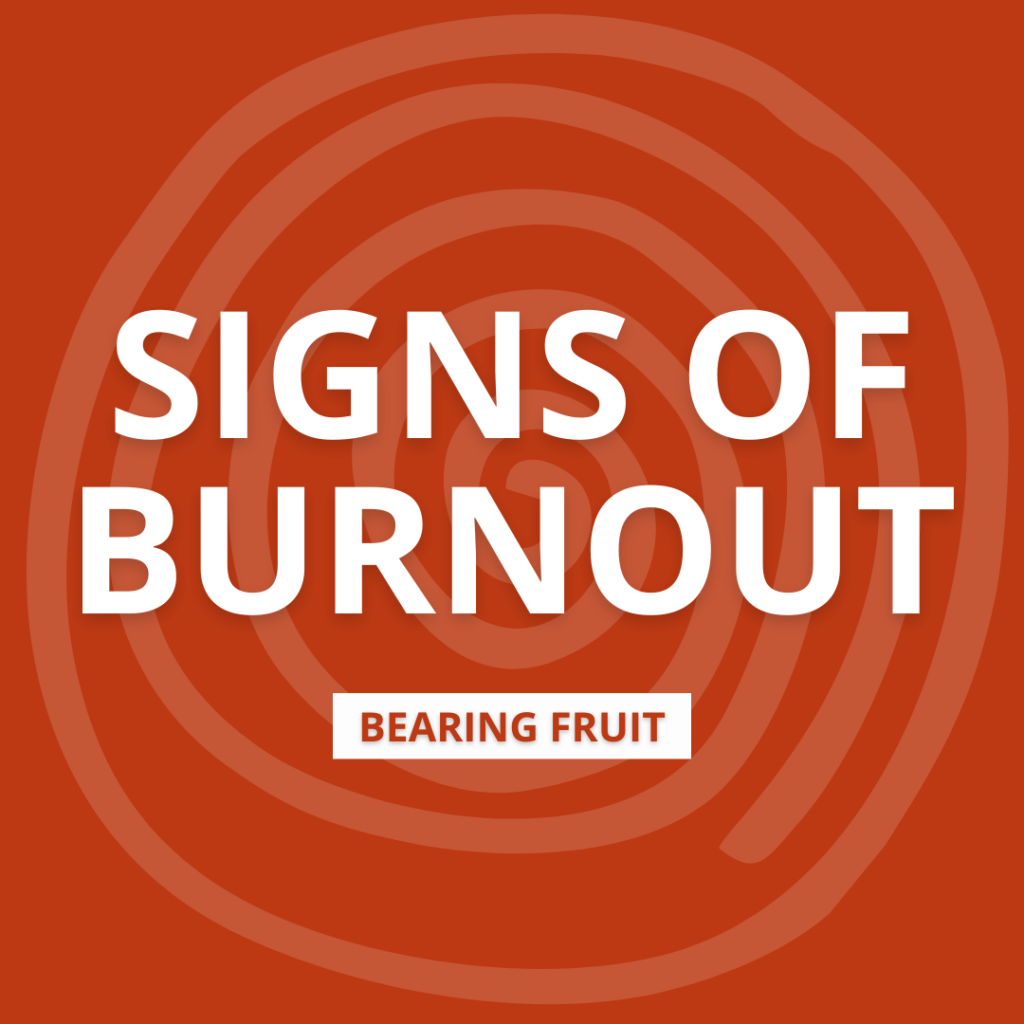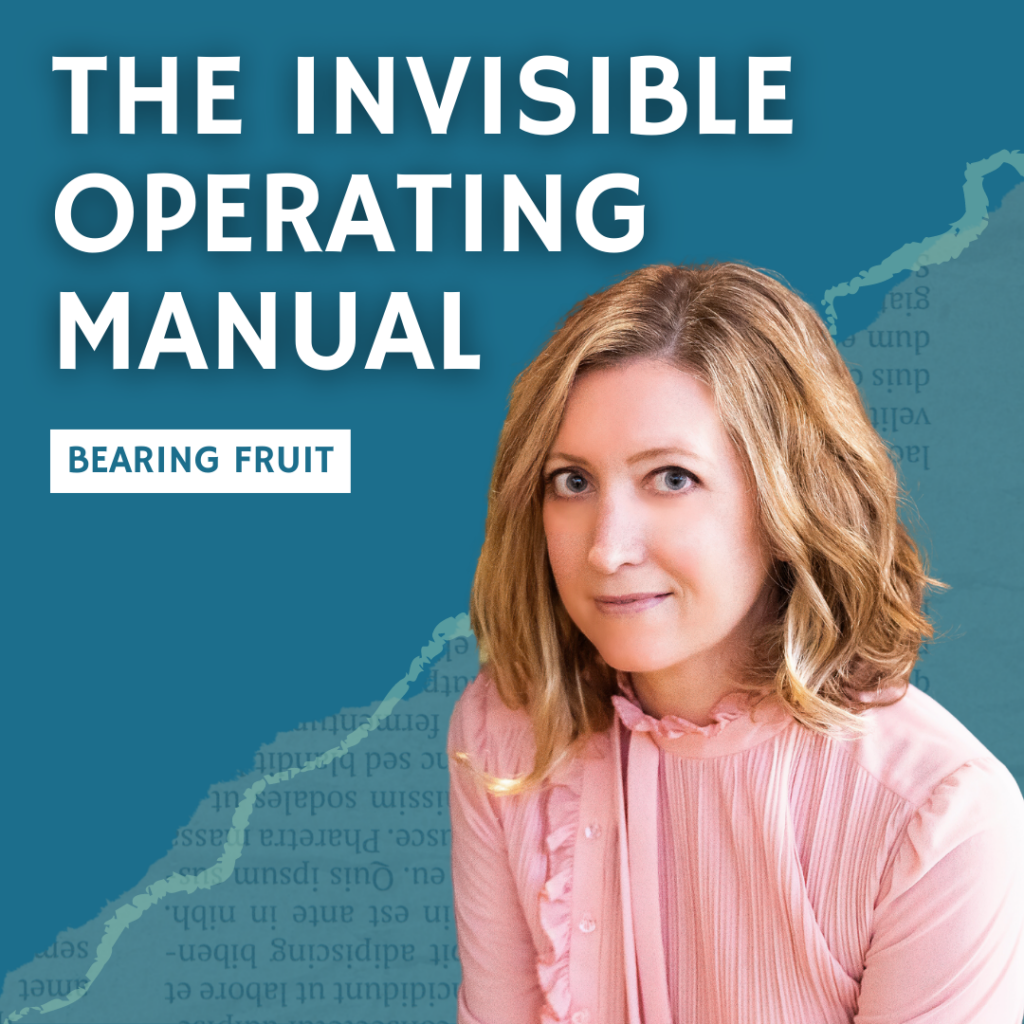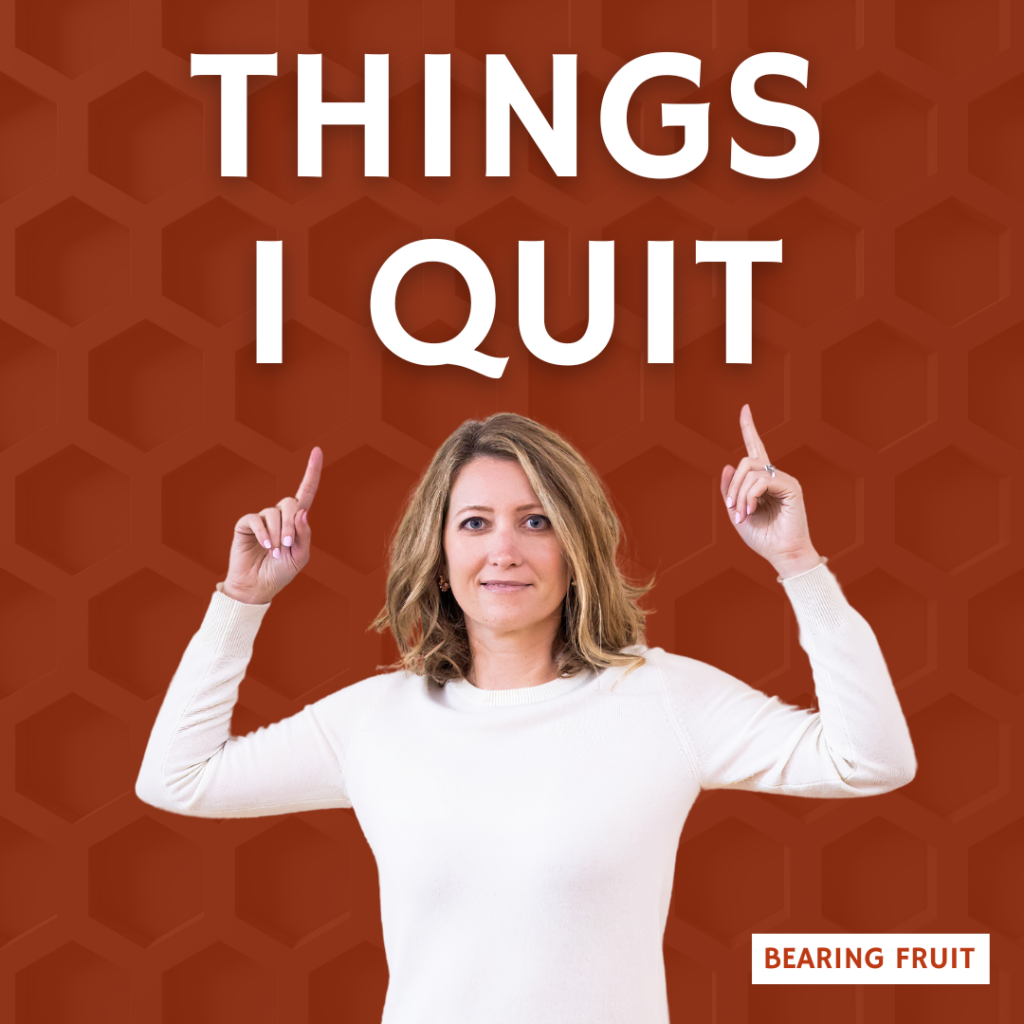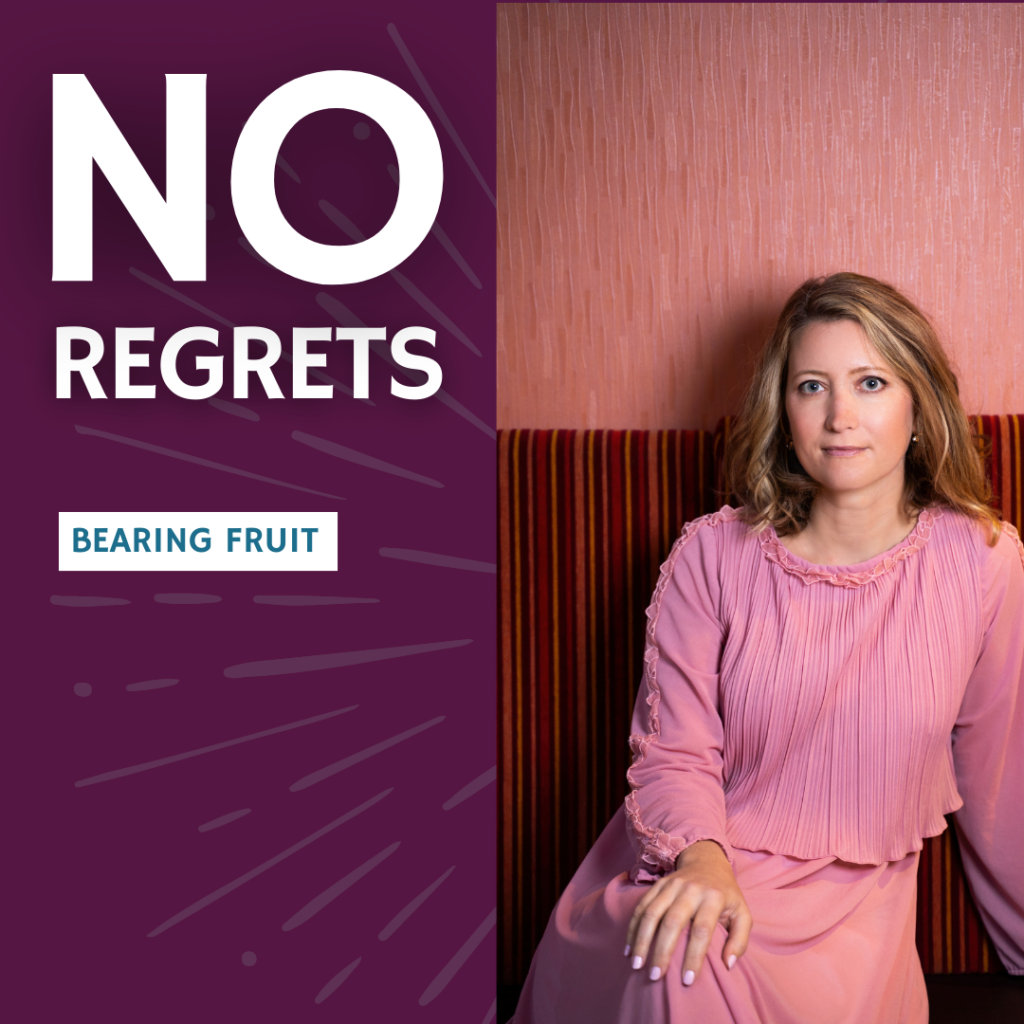Signs of Burnout
The surest sign of burnout is when your emotional reactions are disproportionate to the event itself.
The real work is in understanding how that disproportionate reaction manifests for you, so I’m gonna lay out some examples from my life in hopes that you can recognize yourself somewhere in here too.
Personally, when I’m burned out, my emotions become so fried and fragile that I cry at just about anything.
Another email from someone interested in booking a workshop with me? 😭 because I just can’t handle one more thing. When an appropriate, proportionate reaction would be to hit reply and politely decline.
I’ve also overate or overdrank. One glass of champagne to celebrate the launch of a new product makes sense. Three glasses is an attempt to drown your stress.
In 2020, I quit sleeping well. Getting 4 hours, max. Usually woken up by a pounding chest and drenched in sweat. I thought it was very early menopause. Or possibly a heart murmur. Turns out it was just stress. Your body disproportionately reacts on your behalf. (Other body clues: You get sick.)
Friends of mine have gone blank. They’re so overextended and exhausted that nothing really registers anymore. I get texts like “I don’t even remember the last three hours of my life.”
Like, the kids said they were hungry and you went through the motions of throwing together some mac and cheese while answering work emails while the preteen prattles on about what happened in Mythic Quest while….
A normal reaction would be overwhelm. You’d close your laptop. You’d focus your preteen on dumping the powdered cheese food product onto the noodles. A disproportionate reaction would be to fracture yourself into so many parts that you aren’t you anymore and therefore your brain doesn’t function.
Other forms of going blank: mindlessly binging TV or social media (this includes YouTube), playing solitaire on your phone for hours, not wanting to get out of bed.
Readers show me they’re burned out when they reply to my newsletter with an angry five-part essay about how wrong I am.
Hear me out – I’m definitely not always right.
But a point-by-point fiery dissertation? When someone starts multiple sentences with “In fact,” inside the same paragraph? Honey, you sound like you need a hug, a nap, and…
The only solution to burnout is to *permanently* cut back your responsibilities.
Some ideas:
Shrink your team.
Institute a 4 day work week.
Raise your rates and take fewer projects.
Drastically shift the distribution of household labor.
Pick a date that will be your final day at your salaried job.
For sure:
Burnout can’t be solved by sending the kids to the grandparents for the weekend.
A vacation in the Caribbean sun will be nice but it isn’t a cure because as soon as you get back on Monday you’ll be stepping directly into all the burnout-inducing chaos once again.
Tools to regulate your nervous system, like yoga and meditation, can help you bear the current stack of (too many) responsibilities but they don’t fundamentally change your circumstances.
Do you see yourself in here anywhere? What are your burnout signs? How long have you been experiencing them? What permanent changes are in store? Tell me.
To What End?
The best guidance my therapist ever gave me was through posing this question: To what end?
I musta been on a typical complaint about being stressed from work. Work I love. Work I made, since I started my own company. But still. So much of it.
She asked: To what end? Why are you working so much?
Me: So that I can save the world and help people and make a bunch of money along the way.
Her: To what end?
See, the world will never be “saved.” At least not by me. Not in this lifetime.
The number of people I could potentially help is well beyond my capacity, even if I grew a staff of 10,000. I’ll never be able to help them all.
And the money? You know it’ll only take you so far.
So… what’s the end game?
Up until that point, my loosely-defined goal was “as much as possible.” Let’s aim for infinity and make the journey fun.
Except that’s not reality. When you’re doing this:
It doesn’t matter if the chocolates are worlds to save, lives to improve, or dollars in your bank account, you get sick. It’s gross.
This is how you burnout.
“To what end?” forced me to think about a better defined business goal. Because your goal ultimately shapes your day-to-day.
Thoughtful small businesses usually have one of three major end goals:
Sell.
In this model, you’ll ultimately plan to sell your company and its intellectual property to someone else. If you’re running for this goal, you’ll likely focus on creating processes you can patent, you’ll trademark things, you’ll strive to product-ize your work.
The more systems you create, the faster someone else can step in and pick up right where you left off. And the easier it will be to get a valuation and enter into buy out talks.
Your day-to-day includes innovating new things and making them replicable and marketable. You might have staff implementing your established processes, but it’s also likely that you have a lot of folks in research and development, testing new patentable ideas.
Think of any tech start up on the West Coast and you’ve probably got a company with a Sell goal.
Though my financial planner has been pressing me to think of selling upon retirement, I’ve never considered that to be my goal for Evergreen Data.
Legacy.
Entrepreneurs focused on making a legacy will spend more of their time building a reputation.
That could look like heavy engagement in thought leadership or book writing. Sure, some thing might get trademarked in the process but that thing is inherently tied to its inventor.
Or it could be more like focusing on an extremely high quality deliverable that makes you incredibly attractive and memorable.
For example, I’m thinking of a dear elder in my family who started an architectural and engineering firm that he named after himself – Byce and Associates. He trained an expert staff and eventually sold the company (Sell!) but the new owners kept the same name because the legacy and reputation were so strong.
Think about your field – those big names are probably in this Legacy category.
Lifestyle.
People running Lifestyle businesses aim to work enough to support their desired lifestyle and no more. Your workload is naturally capped by your personal ambitions.
Lifestyle entrepreneurs tend to see more balance in their day-to-day. They don’t as often work a whole weekend writing another journal article – they’re more likely to be planning their next vacation or working in their garden.
They’re still running a business of course so they’ll still have some thought leadership and some staff perhaps but scaling to a team of dozens isn’t important. They don’t feel a need to leave their mark on their industry. They want to do important work and then go to Greece.
The accountant who earns all the income he needs in the first four months of the year and then closes shop to live his life for the other 8 – that’s a Lifestyle business.
So, to what end?
These are the three primary end goals I see. Each one naturally manifests in a very different daily practice. When my therapist asked me “to what end?” I didn’t know how to answer her and that’s likely because I was trying to do all of these at the same time. It was exhausting me.
These end goals aren’t mutually exclusive, they’re more like the three corners of a triangle. You can be anywhere in between. I personally go back-and-forth between them in different seasons of my life.
Where do you think you are right now?
No Bar, No Pizza
Summer 2023 I was one of the swarms of Americans who knocked around Italy for vacation.
Venice, though beautiful, was shoulder to shoulder with tourists. It felt like being in the world’s loveliest but most popular nightclub. If there could be fire codes on sidewalks, Venice would have set off alarm bells.
That’s why No Bar, No Pizza impressed me so much.

Trattoria al Vagon is a well-regarded restaurant, right on a canal, serving traditional Venetian food. It’s the kind of place where you need a reservation for dinner.
But they’re also on a main thoroughfare with throngs of people shuffling by shoulder-to-shoulder throughout the day. If you’re thinking profitably, it would make sense to open earlier in the day. Even all day, since these tourists are jet-lagged and their stomachs don’t know what time it is.
So they compromised a smidge and extended the hours to attract the pockets of people walking by.
And then swiftly realized these tourists have no taste.
All they want is pizza and an aperol spritz at 10am.
Would you appease this clientele even further and install a pizza oven and a bar?
It would mean more capital investment.
It would also mean compromising your quality, your reputation, your ethics – that much more.
They said no.
And posted a handmade sign in large, all caps, English language letters: No Bar, No Pizza.
Don’t even come sit down and waste our staff time if that’s what you seek. There are 100 other restaurants within spitting distance that can meet you exactly where you are.
That’s called boundaries.
Every business needs boundaries – a clear delineation between what you will and won’t do.
You need them because you were likely raised to be a people pleaser so it’s engrained into your personality to bend over backwards for every person who knocks at your door, even if it causes you back pain. And exhaustion. And resentment.
Your best path forward – the path that saves you time and sanity – is the one where you get clear about your boundaries and then communicate them very early on in the process so potential customers can self-select out if their needs don’t match your services.
You need a wooden sign that says No Bar, No Pizza.
I write my boundaries down, because otherwise I’m likely to forget that I made them. That’s how I navigated through a recent situation where a potential client asked me to teach Power BI workshops for beginners, intermediates, and advanced students.
For a day I deliberated.
Then I remembered that I’d have to stretch myself to teach those workshops and they’re technically outside of my wheelhouse. I remembered my boundaries. And I referred this potential client to a colleague.
Boundaries are how I knew how to respond to a potential client who was pressing me to schedule a workshop before the end of the year, even though I’d already told them I have no availability.
Could I have found a way to squeeze them in? Sure.
But it would have hurt. There’s a reason I already put a boundary in place about no more work this year.
So, my friend, what’s a boundary you need to put in place to protect your time, energy, and mental health? Write me with your version of No Bar, No Pizza.
The Invisible Operating Manual
The Protestant work ethic is so deeply ingrained in American culture that it’s hard to even know you’re operating according to its instructions. Like the fish who doesn’t know it’s in water. Swim with me and let’s identify the fluorescent-colored rocks that have been making up our belief systems about how we work.
I’m not necessarily saying any of these Protestant traits are bad. If you’re Protestant, do you. I believe it’s incredibly helpful to understand the indicators of the Protestant mindset that have influenced our collective psyche so you can decide for yourself if these notions are helping you or getting in your way.
Work should be hard.
This is the root of no pain, no gain. If it doesn’t hurt, you’re lazy.
Hard work is part of the same United States mentality that allows people to go unhoused and unsupported; the thinking is that they should have just worked harder.
I know you’ve got a big heart so you don’t think that about the people you see on street corners with cardboard signs. But how often have you chastised yourself with that same thinking – I should have just worked harder.
Another important component to this ethic is that money should only come through blood, sweat, tears, exhaustion, sacrifice, and at the expense of your mental health and relationships. That if you make a lot of money and you’re only working 20 hours a week, you’ve cheated. Gain without pain is unethical.
But yall… look where that’s gotten us *gestures wildly at everything*.
Pay your dues.
Work your way up the ladder. Start as a junior assistant, work 80 hours a week for two years and become assistant. Two more years to senior assistant. I was sold a similar tale when I worked at the university. But then one day I realized there are 10 senior research associates all eyeing the one deputy director position, so…..
But gosh the university sure benefitted from our labor by selling us that Pay Your Dues story.
It’s this thinking that casts a side eye toward the young entrepreneur, questioning her gall and experience. As if she hasn’t put in enough hours to earn a CEO title.
Look, there’s a grain of truth here right? You do get wisdom with experience. But hours of butt in chair does not equal experience. It’s what you do with that time.
Save what’s left.
Protestant work ethic says that your job is your calling. You should dedicate all of your energy to it because, they think, this is what God wants you to do – it’s what gives your life meaning. Of course this leads to burnout.
It also means you shouldn’t engage in other activities. Like a personal life. Cause that’s outside your calling.
So if you do have some extra cash on hand, squirrel it away. Don’t invest in your rest. Don’t take a class for your personal growth. Don’t upgrade your quality of life.
Save What’s Left is also tied to the Protestant work ethic of self-denial. You come last. This explains why so many fresh entrepreneurs don’t even pay themselves.
Reward is in the afterlife.
The whole deal is predicated on this promise: You toil your tushy off because that’s how you show God you’re worthy of heaven. Whether or not you believe in heaven, a similar promise shows up in Pay Your Dues. And the whole notion of retirement.
Can I be honest? I’m a little scared of retirement. Because everyone I know who is retired 100% bought into this Protestant work ethic and as far as I can tell, it kinda sucks.
Sure you have more time to spend with the grandkids and that’s super cute. I just don’t see that many retired people who are truly, deeply happy and living the life of their dreams. They’re tired. Cause they worked 80 hour weeks and didn’t make time along the way for the things that actually create a happy life.
Is this what you want?
These ethics are the building blocks of capitalism and exploitive labor conditions. These ethics define that middle class American lifestyle that takes a vacation once every five years and has 2.5 kids. And, again, no judgies if that’s what you want.
I just want you to be aware that the definitions of success come from a very specific perspective. They aren’t universal. They definitely don’t work for everyone. And they probably have seeped into your internal narratives and it’s ok to question whether those are subscriptions you want to keep active.
Things I Quit
You’ve gotta quit in order to grow. The old model of growth by adding more and more and more is unsustainable. It leads to burnout. It’s bad for the health of the community, the planet, and you.
I didn’t totally recognize that when I first started by business. My editor asked me to write a book and I was so full of that young, I-can-do-anything energy that I said yes.
Thinking I’d just tuck it in around the edges of my life.
Getting up early, before my kid.
Staying up late, after everyone else had gone to sleep.
Taking weekend retreats in the woods to write, rewrite, and reread my own words for the bazillionth time.
It worked, but I ended up resenting that book.
Since it takes me a long time to learn from my mistakes, I wrote a second and third book using the same burnout model.
After the third book I swore I’d never write another. The process spent me.
I hadn’t adequately prepared my time and energy for that level of growth.
See, that growth did cause me to cut things – though I didn’t consciously understand it at the time. I cut time with my family and friends. I cut sleep and deep rest. I lost a summer of bike rides.
And when you cut out the things that bring you joy, you get resentment.
Seems so obvious, doesn’t it?
Yet we typically don’t face these facts and make thoughtful choices about what we’ll cut in order to make space for the incoming opportunities.
So now I know better. When I write down my quarterly or annual goals, I also write a list of the things I’ll quit so I have the room to accomplish those goals.
This drop list was from 2015:
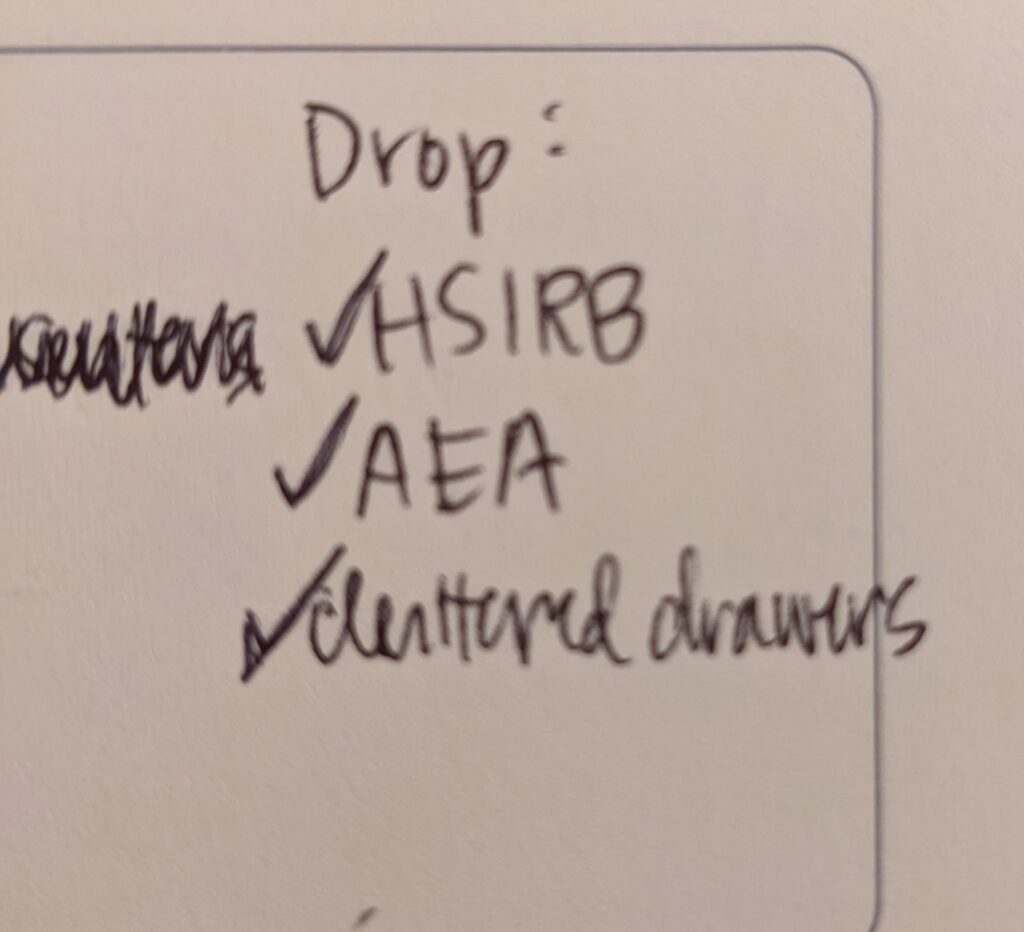
I quit my spot on the local Human Subjects Institutional Review Board (and currently have a ban on all committee work). It didn’t fit the way my career had evolved anymore.
I quit working for the American Evaluation Association, who chronically underpaid me.
And I quit having cluttered drawers because it messes with my peace of mind.
Another year, I wrote:
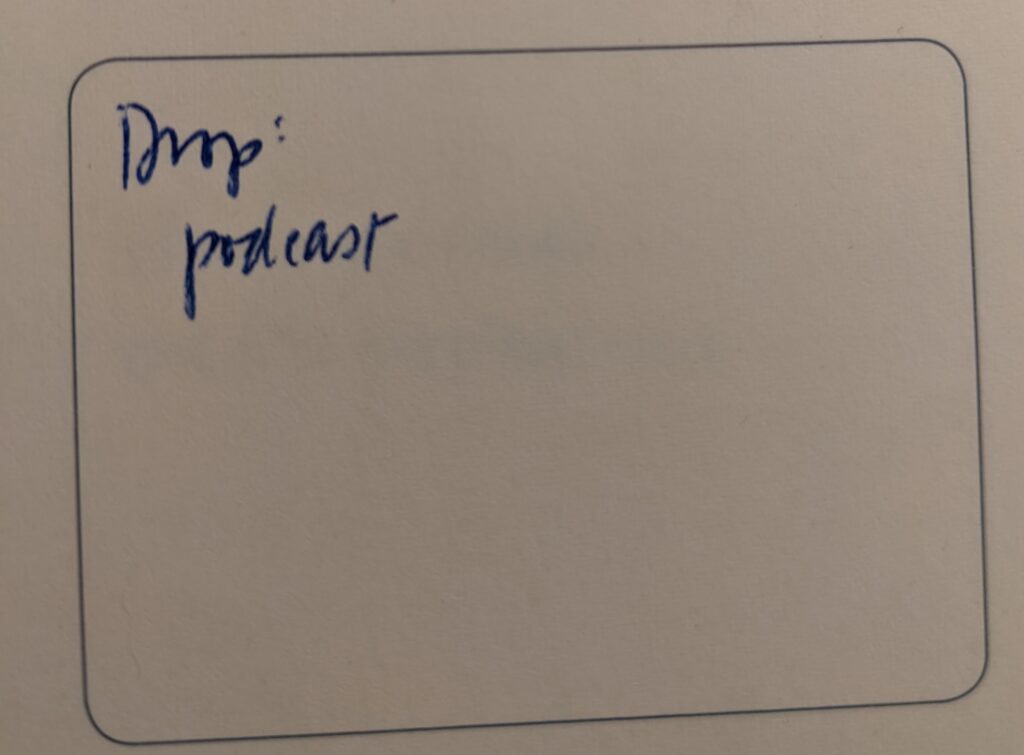
That was the only thing. I quit hosting a podcast. It took up a lot of time and the more I got to know my cohost the more my internal alarm bells were going off.
This quit list came in prep for the year I knew I’d be writing books two and three:
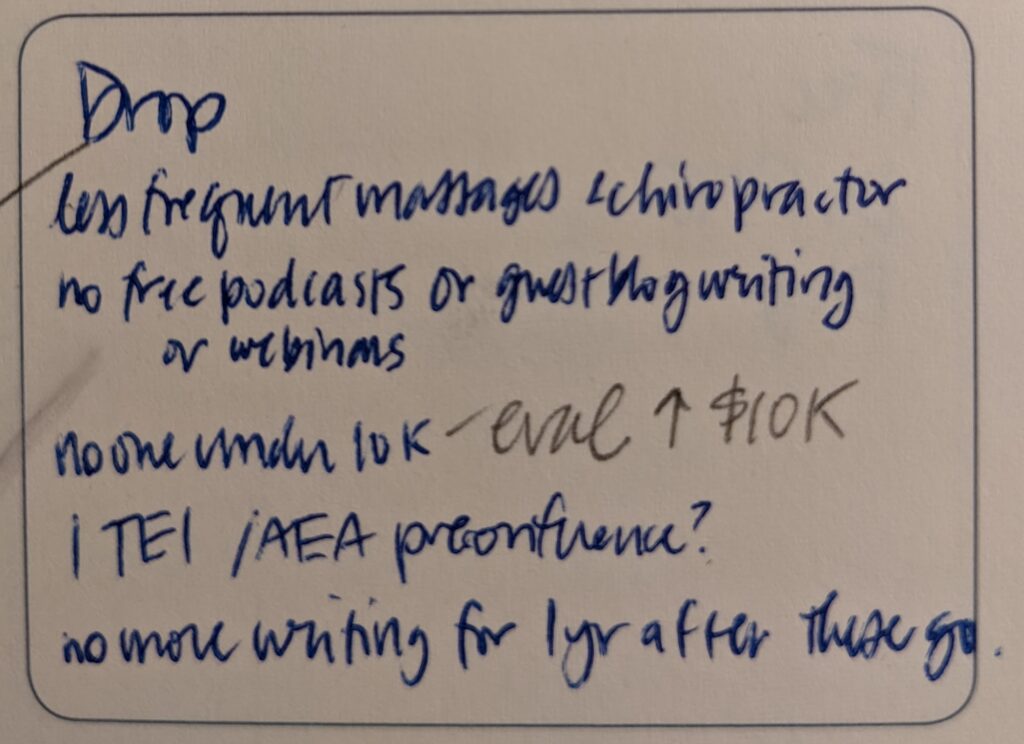
I actually said I’d quit having such frequent massages and chiropractic adjustments! What the hell was I thinking?! It takes me a while to learn from my mistakes.
I quit writing for free on other people’s blogs.
I quit working for small projects, which take just as much admin time as big projects.
I significantly cut back on holding workshops for organizations that paid me far under what I was worth.
And I predicted I’d be done with my post-book recovery after just one year. LOL.
More recently, I quit taking on work with people or companies that don’t align with me. And I quit reading emails from my kid’s school’s PTA – bye, guilt!
Each of your goals should also have a quit buddy.
It’s been five years since I wrote a book. Each year my editor gently asks, in her hard-to-say-no-to London accent, “Can we put our heads together about another edition?”
I’m still not sure I feel ready. It’s taken five years to recover from the burnout.
This time around, I’m not saying yes until I can identify the things I’ll quit.
I’m not willing to sacrifice sleep, personal time, or exercise.
I’m not gonna give up writing you emails or getting into the Boost & Bloom Office Hours to answer your burning questions.
So what is gonna give?
Without a doubt, I’ll lose out on income. Books are not lucrative and I’ll have to quit taking on so many data viz workshops.
And that’s as far as my thinking has evolved right now. Which is why I haven’t answered my editor yet.
The hardest: Quitting what you started.
It’s pretty easy to identify the things you’ll quit that bring you resentment, like that committee. Sooooo much harder to let go of the things you founded.
A Bearing Fruit reader reached out on a different topic but in the process of introducing herself, she listed out all the extra curricular groups she’d launched or was currently chairing. I could see the squeeze those were putting on what she really wanted to do with her time. So this part is for you.
Nobody wants to let go of their babies. Even if it means the baby has taken all your fruit and cut your branches (ever read The Giving Tree? It’s dark!). You’ll feel better about leaving it behind if you send it off with some guidance.
Write up some guiding principles for that group you started. Make a wish list. Develop an operating manual. Then pass it all on to someone else (yes – you give other people leadership opportunities, which is very cool). You get no guarantees that they’ll abide by your instructions. Hope they’ll make your baby even better.
If it dies on the vine – that’s what it was supposed to do. No org, club, interest group, or adventure can sustain on the labor of one person (you, Babe).
You can always come back in five years and run for vice president. And no matter what, “Founder” stays on your resume.
My friend, what’s on your quit list? Shoot me an email with the next thing you’ll quit, as soon as you need to make space.
Batch, Please
Working from home has so many upsides: a 30-second commute, a dress code that includes slippers, and free cat pets all day long.
Working from home also has a major downside: Interruptions.
UPS ringing the bell with another delivery. My partner telling me he’s going out. Even good interruptions like a delicious hug from my teen before he goes to school and that purring cat finding a home on my lap – still interruptions.
When our brains have to switch gears, even momentarily, it takes us a ton of time to get back on track – like 25 minutes to refocus and get back in the groove. For every distraction.
This article from the American Psychological Association says we lose 40% of our productivity when we task switch.
There’s a switch cost.
While I’m tempted to put a KEEP OUT sign on my office door, I have to admit that it’s me. Hi. I’m the problem. It’s me.
Like, just now, in real time as I’m writing this to you, I stopped writing after “It’s me” and sang a little Taylor Swift in my head, checked my email, picked up my phone, read a story about how China says it successfully cloned 3 highly productive super cows, and then stared at the keyboard for a while. Why? I even knew what I wanted to write next.
I think I’m not alone.
We’re all highly distractable.
Our brains are delicate little things. If they start to get overwhelmed, they check out. Our sweet lil brains are actually trying to protect us by being so weak. We can’t totally eliminate this issue. But on the other hand, I don’t really have 25 spare minutes to give up for every distraction in my day.
Our weak brains are why multitasking doesn’t really work. If I’m cleaning my desk while “watching” a webinar, I’m not going to pick up most of what the speaker is saying. Even if I believe I’m listening, as in, I could repeat back their last few words, those words don’t have a chance to land in my heart and resonate. Because I’m divided.
Single-tasking, or monotasking, is always more effective. It’s that seemingly contradictory notion that you have to slow down to make progress. One thing at a time, done well, is more productive and effective than two things you half-ass.
Even though Taylor Swift is still running around in the back of my brain somewhere.
The way to make single-tasking really work for you:
Batch.
Batching means you collect all the very closely related tasks and do them in the same span of time. A single-tasking streak.
Let’s take every entrepreneur’s favorite job: Chasing down clients who owe you money.
Step One: Psych yourself up to address this. That’ll take an hour and a latte run.
Step Two: Open your computer, get into your invoicing program, and locate the unpaid invoices and the date you sent them.
Step Three: Dig through your emails to find the last time you communicated with that client.
Step Four: Write an email that perfectly balances humor and professionalism while thinking to yourself “eff you, pay me.”
Step Five: Reread it five times. Remove some exclamation points.
Step Six: Hit send.
Ok so if you chase one invoice per day, girl that’s your whole morning.
But if you batch your invoice-chasing all in one sitting, you at least don’t have to repeat the costly steps one and two over and over. The time it takes to write the second email will be a fraction of the first because you already did all the hard work (and who am I kidding, I know you’re gonna copy/paste).
I block my batches in my calendar.
Today, for example, is blog writing day. I’m in the zone and I stay here, just writing love letters to you. I don’t have to re-get in the zone for each new post.
Big Boss Time is when I have to make hard policy decisions, write difficult emails, and fire clients.
Follow Up Hour is when I reply to all the folks who contacted me looking for workshops.
Video Day happens because I want to get into full hair and makeup as infrequently as possible.
My brain feels less stressed and more streamlined when I batch my work. Batching reduces the switch cost.
What could you be batching? Give your batch time a fun name and then email it to me.
No Regrets
This is going to sound like a bummer way to start but hang with me, it’ll be brief: My grandma passed to the other side recently. You don’t need to email me with condolences. It’s all good.
I didn’t realize, when I hung out with her the night before, that I’d be the last one to speak to her. She was retrospecting on life. I asked if she had any regrets. She broke out into a big smile and then fell asleep for a few minutes.
The same day I was visiting my grandma, Big Think published this article on the Harvard Study of Adult Development. The Harvard study and several others that track humans for decades produced similar findings: Life happiness is found in the quality of our relationships.
You’ve probably heard this before. If you’re like me, you’re already thinking “yeah, yeah,” with your hand on your mouse, ready to go scroll Instagram. Hold on.
If you want to be satisfied with your life, you’ve gotta invest in your family and friends. This is terrible news for people like me who have a hard time making new friendships as an adult.
The Big Think is careful to clarify that loneliness, which is what kills you, is “people who are more isolated than they want to be.” So if you LOVE being by yourself, do you, Boo. That’s a little freeing, right?
As long as you’re being honest.
If you think you’d like to be a little less isolated, let me tell you what I’ve been noticing.
People place bids.
Bids are tiny little invites to connect.
Perhaps a decade ago, I got new neighbors. They were from Montana. They raised backyard chickens that we’d watch when they went home for the holidays. She worked remotely and when she found out I was also typing away in my house all day, she said “Hey if you ever want to take a work break, hit me up and let’s go for a walk or something.”
Looking back now, I can see that was a bid.
I never took her up on it. I wanted to, sure. But there was always some Pressing Work Thing I needed to attend to instead. That’s what serious CEOs do. They don’t just vacate the office when there are Important Emails to be Answered.
A few years ago, they moved back to Montana because they missed the community.
Now I’m not saying I could have changed the course of their lives or something, but I definitely could have closed the laptop and enjoyed the company for 45 minutes once a week. You walk with someone for 5 years and you form a bond. (Also, just sayin, I coulda used the exercise.)
Work will always be there. The opportunity to create those life-satisfaction-building-connections will not.
I missed the bid and I regret it.
Now I look out for them and I intentionally bid all over the place. Lunch on Friday? Yes please.
Happiness requires a mindset shift for entrepreneurs.
There’s a very American work ethic we’re subscribing to, whether or not we’re aware of it.
Work hard now for future rewards.
Nose to the grindstone gets you a massive nest egg and a glorious retirement. Right?
Except whatcha gonna do with all that money and free time? Hang out with… who, exactly? Those friends you never nurtured along the way?
Please be cautious of promises of future reward.
Shifting our mindset would look like:
Blocking out four weeks of vacation in the year, even if you don’t have a destination in mind, even if you just stay home and enjoy the quiet time. Pick whole weeks or block out every Friday. You’ll figure out what to do with the vacation days, trust it.
Scheduling friend dates during the “work day.” Go for that walk, hit up that Indian buffet. I promise, you’ll feel like you had a good day.
Eating on the good plates and drinking out of the good cups. I know you normally reserve those for special occasions but I’m confident you can find something to celebrate every day, if you look for it. Today I finally took my dress to the tailor. Celebrate your accomplishments!
Giving people their flowers, while you can. Don’t wait until your colleague tells you she’s quitting to say “Oh shoot, I really like working with you.” Tell her now. Glow up that professional peer on your socials. Take a deep breath and tell your grandma exactly how she made your life better.
Let’s have faith in the fact that this isn’t going to turn into some YOLO sprint to bankruptcy court. You’re committed to growing your business and building a legacy.
It’s just that the legacy we leave for the next generation shouldn’t just be a big bank account. It should also be an example of a life well lived.
Small Projects are a PITA
Sarah posted in our group chat “Ok, I have to admit, I underestimated the budget for this project. They didn’t have many funds and the scope was reasonable… but the admin! I’m spending almost as much time doing admin tasks as I am actually working on the project.”
Yes, my dear Sarah. This is why small projects are a PITA (one of the only acronyms you actually need to know).
I’m not saying you should never take a small project, so don’t hit reply and email me in all caps just yet.
Small projects are often the ones that steal your heart.
They’re that local non-profit that you’ve always loved. They’re the scrappy folks, just like you.
You’re in solidarity. So you say yes.
Then you engage in the same tasks you have to do for any project, no matter the size, aka, the administrivia.
Administrivia is all the little stuff that isn’t directly about providing the actual service.
Paperworking.
The contracting.
Plan development.
Client hand-holding.
Filling out the time sheet.
Sending updates each week.
Getting into the vendor system.
Scanning receipts for reimbursement.
I’m allergic to administrivia.
And the thing is – it’s essentially the same for all-sized projects. Which means when the project is small, you spend a ton of time, relatively speaking, on the administrivia.
That’s usually the stuff we don’t account for when we’re looking at our calendar and thinking “yeah, I can take on that small project.”
The extra bonus sucky part about administrivia is that it isn’t the stuff that lights us up. Our hearts glow when we’re actually working directly with the client, not when we’re chasing down payment on the overdue invoice.
When we spend hours each week on administrivia tasks that we don’t love, we feed the resentment monster and put out the welcome mat for burnout.
I got an email from someone in response to my 5 Projects advice, saying she is *happy* to have 15 small projects at once.
I’m definitely not trying to call anyone out, so I won’t share any further details. You’ll just have to trust me when I say that the tone of the email was like this:

Her burnout was evident. Even if she truly loved each of her 15 projects.
Let’s say you’ve got 15 small projects right now and you need to find a way to reduce the effort while still fulfilling your scope with the quality you’re known for. Here’s what you can do.
Cut down administrivia.
- Reduce paperwork, like charge a flat fee instead of getting reimbursed and having to scan and email receipts.
- Be honest “The size of the budget for this project doesn’t allow for x. If you need that level of administrative oversight, we’d need to find more funding.” And sometimes they will! But often they’ll say “Ok no prob.”
Consolidate efforts.
- Is there a way you could turn this into a group thing? Like if you have several small projects and they all need a meeting about why you collect survey data in a specific way, can you get them all on the phone at the same time? If they all need a monthly update, can you schedule one 1-hour Zoom and assign each person a 15-minute slot? Can you negotiate to ditch the monthly update altogether? (After all, it’s easy to argue that a monthly update is administrivia.)
- Use this as an opportunity to build some systems. Are you writing the same messages over and over? What can you begin to copy/paste? Are you going for a 45-minute walk to psych yourself up for writing those emails asking when to expect payment on the invoice? Batch invoicing – write those emails all in one sitting.
Shoot bigger.
- Start talks about phase 2 or contract extensions right now. Maybe you can turn this into a bigger package.
- Seek out the funders, who can support your technical assistance for lots of their small grantees, but under one funding umbrella.
- Aim for 1-2 big projects to replace a few small projects. That way you aren’t completely ditching your tried-and-true bread-and-butter. But you’ll get a better balance. I promise, you’ll find heart-stealing projects that are bigger, too.
What else could you do to cut down on administrivia and make small projects more viable? Any ideas? What’s your least favorite administrivia task? Email me.
It can feel scary to level up your game and start going after bigger clients. Can seem like you’ll lose your soul if you do. In Boost & Bloom, I’ll teach you how to grow with your soul intact. Enrollment opens February 1. I’ll open the doors early for people on the VIP list – and give ya a discount. Get on the VIP list here.
I Can’t Relate
It’s so freakin hard making friends as adults. Right? Is it just me?
I’d heard great things about a book on how to make friends when you’re all grown up, and I checked it out from my library.
You might resonate with this book, so I’ll link to it here. Spoiler alert: The author lives in the Bay Area. And in the introduction, talks about the dozens of meetups, potlucks, and events she gets invited to every weekend.
Cool for you, but I live in Kalamazoo, Michigan. We don’t have a dozen of anything around here. Except donuts. Because: Smaller town, midwest. So if you have trouble making friends in the Bay Area, what hope do I have?
I’m going to finish reading the book, because that’s my personality, but my skepticism is high and the author’s credibility has sunk.
Reality, please.
In fact, two of the most popular people in the online course and coaching space (where I spend a lot of time) pride themselves on being (1) lazy or (2) highly productive. They also don’t have children.
Neither of these modes of living are possible when you have children or aging family members to attend to.
I can’t be lazy when I have to pull in all the income for my household while helping my teen navigate his first experience in the job market and helping my grandma get her CBD pain relief sorted out.
I also can’t be highly productive at work for the exact same reasons.
It’s gotten difficult for me to hear advice about how to Do Life from people who have the ability to solely focus on work, instead of being split in a bazillion directions by all of life’s duties.
A realistic work day.
My reality is that I have to work (so, good thing I like it). And I have to be extremely thoughtful about how I work because my time is at a premium. And that’s the part we don’t talk enough about.
Realistically, I can only tackle 1 or 2 big things in a work day. Then my brain has quit and my kid is calling for me. I can sneak in a handful of smaller things around the edges but it isn’t honest or true to add more to my to do list or calendar.
In fact, seeing items on my to do list still there a week later only causes me more stress and pressure. That I brought upon myself. And that, my friend, is a bad mix for mental health.
Your schedule and productivity won’t look like someone who is kidless and carefree. Someone who doesn’t have elders to care for. Someone who doesn’t struggle with being neurodiverse. Someone who’s position in life makes it easy to fly to Costa Rica for a weekend spa trip.
Life is hard and I want to listen to people who acknowledge that.
I think that’s why this is my new favorite Instagrammer.
Real advice.
So my advice is to get honest with yourself about how much you can actually accomplish in a day. And then be ok with that.
Also – and this is a hard one for me to do – it’s ok to get help. Help can look like swapping childcare with another entrepreneurial friend so you both get some solid, quiet blocks of time. Help can look like hiring a personal assistant for a few hours a week so you can focus instead of prepping meals.
When I started my first business, I was so young and energetic and trying to do everything without monitoring my energy levels. In case you didn’t know, that’s a quick way to burnout.
I went to a gathering of other small business owners and beelined to a circle talking specifically about work-life balance. Right as we were being shushed to turn our attention to the main event, I whispered to my circle leader “Hey, I think I need help. Like, is it ok to hire someone to clean my house?”
I felt so weird asking that question. My roots are real humble and this seemed like a majorly bougie move.
She whispered back, “I have three kids. My housekeeper comes twice a week.”
I’ll never forget the relief she gifted me with those two sentences.
It still took me a while to get over my mindset stuff and realize that I could afford the housekeeper and then some if I was able to spend a little more time on cool work projects.
Point is, you don’t have to do everything. In fact, you physically (and emotionally and energetically) can’t do everything.
So choose what you work on carefully.
Go for high-yield projects.
Get help where you can.
Try not to compare your progress to other people you see online. That dude who somehow whips out a new book each year? Who’s feeding his children? How much time does he spend with his partner? When’s the last time he hung out with friends? (Does he have friends?)
I know you know it but I’m going to tell you anyway: Comparison is the thief of joy.
Which also means: filter where you get your advice. Listen to coaches who get where you’re coming from.
On that note, help me out here. Who are you listening to for business advice – and is actually relatable? Shoot me an email with a link to their social.
Or are you trying to navigate without a guide? If so, check out Boost & Bloom. Enrollment opens again in Feb. And in the meantime, email me and I’ll tell you who other people are listening to.
Your Limit is Five Projects
Breaking News: You can only handle 5 projects at a time.
New research out of University of Liverpool reports on analysis of 9,649 data points and it’s showing that when you get beyond 5 projects, you start to lose your mind and burn out.
Isn’t that incredibly helpful information?
Or am I the only one that finds comfort in being data-driven?
5 projects at a time. That’s it.
So here’s how I’m using this idea to plan for an ever calmer, more sustainable 2023.
As usual, I made my grid for the year, blocking out each month in a 6 x 2 matrix so I can plot out my projects and anticipated income.
In previous years, I’d just cram each month’s square with all the projects I committed to and their associated revenue so I could track my monthly dollars and see the balance of my work across the year, on one page. Helpful, to be sure.
But this time around I made an adjustment: Each month is now a numbered list, 1 to 5.
Each workshop I book will fill one spot. Each consultancy. When the 1-5 has been filled for a month, I make a little x to show it’s full. Then I tell clients “Oh sorry, May is booked. My next opening is in June.”
And when I can see the whole year like this, I can also plot out unpaid events I know I’ll have.
For example, here’s my Fall 2023:
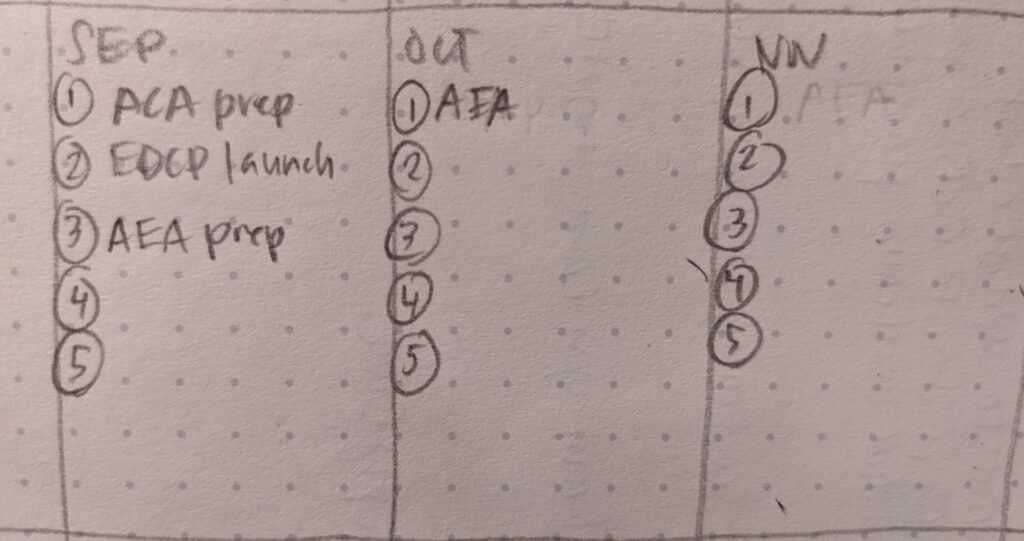
Usually my massive conference is held in November, where I market and network and make new friends and clients and hug all my people. It’s the best.
It’s also a whole project. It typically takes up one spot for November.
But next year they’ve moved it to October.
Which means my prep will happen in September, when I’m getting my talks together and planning the parties I’ll host at the conference. Whew.
September is the same time I’m launching a course and prepping for the launch of another course.
Now I can look at September and recognize, months in advance, that I won’t have much time for paid work. I won’t overbook my September because I can only do 5 things and massive conference prep is definitely one of those things.
This means, if I’m following the 5 projects philosophy, that I have to take on one less paid project in September, in order to plan for one less paid project in October.
Gosh, that conference starts to take on a different sized budget.
Better make sure I’m working my ass off to get the most out of that conference experience.
The holidays take up one spot in December. Not even work-related but it takes up a whole spot. Because the more I thought about this five project limit, the more I realized it isn’t just about work.
Got a fresh baby? That’s one or two spots on every month until your kid is 3.
Dealing with an aging parent? Fill in a spot. Or three.
Old Stephanie would have scoffed a bit at this research. Like “oh yeah the average person can only handle 5 projects, but me? I’m freakin good at this. Bring it on.”
Old Stephanie burned out. Repeatedly.
Health is recognizing the limits of our capacity.
We can put a lot of pressure on ourselves (and each other) to be more, achieve more, ever ever more more. And even if we have wised up to the fact that ever more isn’t sustainable, you’re just left wondering, well, what is?
It’s five.
Now we know.
Ok, ok. One research study isn’t enough to warrant such strong words like knowing something.
But I’m going to run with this framework for a year and see how I feel.
Conversely, some students in Boost and Bloom, who are just starting out on their own, are struggling to juggle more than one project at a time. Like, your brain hyperfocuses on making sure this one project doesn’t go off the rails.
Let this research be an encouragement to diversify your portfolio a little.
Small projects count. The researchers point out that part of the burnout comes from the administrative time and energy to run a project, no matter its size, and the task-switching between projects that sucks your brain.
So for people who only have one project in their laser beam and need to broaden their scope, small projects count.
And for people, like me, who need to rein it in and lower their project number, small projects count.
May we see this restraint as freeing.
In January, my 5 will be:
- A two-day workshop with National Science Foundation
- Dashboard development work with the City of Chicago
- Coordination of a workshop with one of my staff for Centers for Disease Control and Prevention
- Prepping for the re-launch of my one-on-one data viz coaching program, opening in March
- Final prep for re-opening Boost and Bloom (I’m so excited!)
What are your five? Email them to me.

